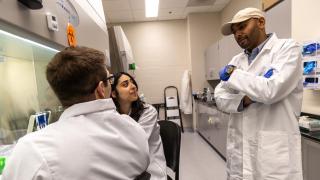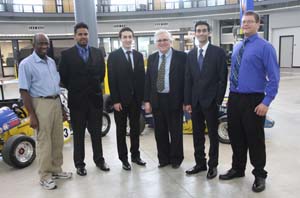

That's why a group of University of Michigan-Dearborn computer and information science (CIS) students has developed a new system for authentication on mobile devices.
The students created the system for Connected Vehicle Proving Center and TARDEC as part of the College of Engineering and Computer Science’s senior design competition. The team – Sidharth Vallabhaneni, Sreekanth Gogineni, Joe Hodges and Liviu Maghear – earned first place within CIS and tied for first overall.
“The goal of our client was to use Apple devices to authenticate personnel and grant access to soldiers while moving in and out of military buildings,” said Sidharth Vallabhaneni, a member of the four-person team. “They also wanted the ability to track and log these transactions.”
The group planned to utilize radio frequency identification/near field communication (RFID/NFC) technology; however, Apple does not currently support this technology. Brainstorming ideas, they decided to work with an external reader to allow for Apple compatibility.
“They took a difficult task – using NFC/RFID on Apple products – and created a solid work around, as they will have to do in their professional lives after graduation,” said Bruce Maxim, who served as faculty adviser along with Kiumi Akingbehin.
The group then extended the project beyond the clients’ initial request. The system is platform independent and built to authenticate nearly anything. The front-end user interface is linked to a backend database that can store any information to be authenticated.
“For example, we can store patient medical information in the backend. The front end would consist of an ID card being read and matched to the correct patient information in the backend database,” Vallabhaneni said.
“Once matched and authenticated, that patient’s information could be shown on an iPhone, Blackberry, PC, Mac or anything with a web browser.”
Other applications include GPS tracking, vehicle security and customized setting, payment processing, and equipment and food tracking.
“Currently, there is no existing software available in the market that provides this type of service and functionality,” Gogineni said.
The students worked on the project for two semesters before presenting it to their clients and to the judging panel at the senior design competition. Lessons learned went far beyond textbook-teaching.
“Learning how to communicate with each other and work with a client was a good experience,” Maghear said. “We were learning how to ask for products and explain things to clients, telling them what was and wasn’t possible.”
Maxim says the experience Maghear mentions is what makes the competition a valuable learning tool as students finish their time at UM-Dearborn.
“The senior design competition reinforces what we teach in our programs,” he said. “Team work, client communication, managing the project to complete it on time with available resources, the ability to write clearly and present their work – these are all important in the professional world.”




